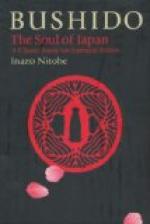Now my readers will understand that seppuku was not a mere suicidal process. It was an institution, legal and ceremonial. An invention of the middle ages, it was a process by which warriors could expiate their crimes, apologize for errors, escape from disgrace, redeem their friends, or prove their sincerity. When enforced as a legal punishment, it was practiced with due ceremony. It was a refinement of self-destruction, and none could perform it without the utmost coolness of temper and composure of demeanor, and for these reasons it was particularly befitting the profession of bushi.
Antiquarian curiosity, if nothing else, would tempt me to give here a description of this obsolete ceremonial; but seeing that such a description was made by a far abler writer, whose book is not much read now-a-days, I am tempted to make a somewhat lengthy quotation. Mitford, in his “Tales of Old Japan,” after giving a translation of a treatise on seppuku from a rare Japanese manuscript, goes on to describe an instance of such an execution of which he was an eye-witness:—
“We (seven foreign representatives) were invited to follow the Japanese witness into the hondo or main hall of the temple, where the ceremony was to be performed. It was an imposing scene. A large hall with a high roof supported by dark pillars of wood. From the ceiling hung a profusion of those huge gilt lamps and ornaments peculiar to Buddhist temples. In front of the high altar, where the floor, covered with beautiful white mats, is raised some three or four inches from the ground, was laid a rug of scarlet felt. Tall candles placed at regular intervals gave out a dim mysterious light, just sufficient to let all the proceedings be seen. The seven Japanese took their places on the left of the raised floor, the seven foreigners on the right. No other person was present.
“After the interval of a few minutes of anxious suspense, Taki Zenzaburo, a stalwart man thirty-two years of age, with a noble air, walked into the hall attired in his dress of ceremony, with the peculiar hempen-cloth wings which are worn on great occasions. He was accompanied by a kaishaku and three officers, who wore the jimbaori or war surcoat with gold tissue facings. The word kaishaku it should be observed, is one to which our word executioner is no equivalent term. The office is that of a gentleman: in many cases it is performed by a kinsman or friend of the condemned, and the relation between them is rather that of principal and second than that of victim and executioner. In this instance the kaishaku was a pupil of Taki Zenzaburo, and was selected by friends of the latter from among their own number for his skill in swordsmanship.




